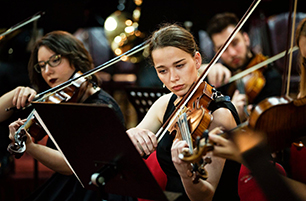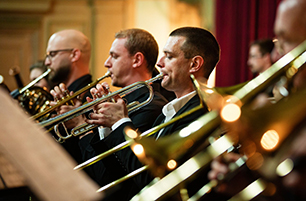
FESTIVALS

CONCERTS

ACADEMY IS MADE UP OF PEOPLE
Academy of Music in Sarajevo was established by the Decision of People’s Assembly of Bosnia and Herzegovina on 20 May 1955, as the fourth higher-education institution of the kind in the former country at the time, and the first one to be established after the Second World War. The Decision was published in the Official Gazette of the People’s Republic of Bosnia and Herzegovina no. 12/55, on 8 June 1955. The establishment of Academy in Sarajevo was preceded by a number of favorable pre-requisites, such as the foundation of a network of music schools, establishment of the Opera of National Theatre in Sarajevo, Symphony Orchestra of Sarajevo Radio-Television, Institute of Folklore Studies, continuity of activities by Sarajevo Philharmonic Orchestra, etc.
At the time of Academy establishment, its founders were:
Milenko Živković, rector of Academy of Music in Belgrade
Dr. Dragotin Cvetko, professor at Academy of Music in Ljubljana
Natko Devčić, professor at Academy of Music in Zagreb
Cvjetko Rihtman, director of Institute of Folklore Studies in Sarajevo
Miroslav Špiler, professor at Education College in Sarajevo
Strahinja Dramušić, on behalf of the Council of education, science and culture of the People’s Republic of Bosnia and Herzegovina, as a recording secretary
Upon the formation of the first pedagogical core, prof. Cvjetko Rihtman was elected for the first rector of Academy of Music in Sarajevo. In the first year of its activity, Academy admitted 42 students. Classes at Academy of Music in Sarajevo began on 19 December 1955, at seven departments:
I – Department of Composing and Conducting
II – Department of Solo Singing
III – Piano Department
IV – Department of Stringed Instruments
V – Department of Wind Instruments
VI – Department of Musicology
VII – Department of Theory and Pedagogy
The initial study program was unique. Although the initial period passed in endeavors to ensure and improve resources, Academy was constantly growing.
Almost all the departments and concentrations began their activity, and Academy began to achieve significant results in educating professional musical and artistic staff: composers, conductors, singers, instrumentalists, musicologists and music pedagogues. Thus, in late 1959, a total of 12 students of the first generations graduated. The first years of Academy’s activity passed in quest of the teaching and teaching assistant staff. The list of the first seven names with which Academy began classes (Matusja Blum, Anton Lavrin, Cvjetko Rihtman, Aleksandar Szegedi, Bruna and Miroslav Špiler, Božidar Trudić) expanded to 65 by the end of decade. These were mostly musicians from the symphony or philharmonic orchestra who fulfilled some of the criteria for work at Academy. There was also a smaller number of teachers engaged from other academies and a certain number of teachers who intentionally came to Sarajevo Academy and remained there (Mladen Pozajić, Teodor Romanić, Vlasta Debelić, Ružica Savić, Vladimir Antolek, Zija Kučukalić, Zlata and Marijan Feller, Izolda Ambrožić, Elly Bašić, Kurt Hauser, Danijel Škerl, etc.). Besides the performances of Academy choir founded by prof. Pozajić, this is a period that witnessed the first students’ concerts in the form of internal and public performances.
Academy’s activity soon reflected to further expansion and quality of the work of educational and performing institutions in Bosnia and Herzegovina and broader region. This was the completion of the first developmental stage in the work of Academy of Music in Sarajevo, whose establishment and beginning of activity were marked by extraordinary enthusiasm by its first rector, academician Cvjetko Rihtman and his associates, as well as the teachers of the first generation of students. The first reform of curricula, of 1962 academic year introduced grading of classes to three mutually linked levels (first degree – two years, second degree – two years, third degree – postgraduate studies). The 1960s definitely inaugurated Academy of Music as the leading educational institution in Bosnia and Herzegovina. It is also the period of a great momentum in the work of secondary schools of music (Sarajevo, Banja Luka, Mostar and Tuzla), which provided top-quality students, besides those who came from beyond Bosnia and Herzegovina. A total of 60 more teachers and teaching assistants’ names were recorded.
A new quality appeared in the names spawned by Academy itself, who were to become significant second-generation teachers: David Kamhi, Aleksije Radan, Bećir Drnda, Đorđe Busančić, Zdravko Verunica, Blanka Kurpjel Danon, Miroslav Homen, Safija Đonlagić, Vojin Komadina, Vinko Krajtmajer, Rajmund Likić, Julio Marić, Josip Jurić, Milica Šnajder, Višnja Zekić, Jasenka Dimitrijević, etc. Academy’s concert season registered 20 students’ concerts on average. Among others, Ivo – Gino Sagrestano, Ivan Poljanšek, Nada Ludvig Pečar and Josip Magdić also began to teach at Academy. IN the 1970s, in its second developmental stage Academy was in a full swing in many areas.


